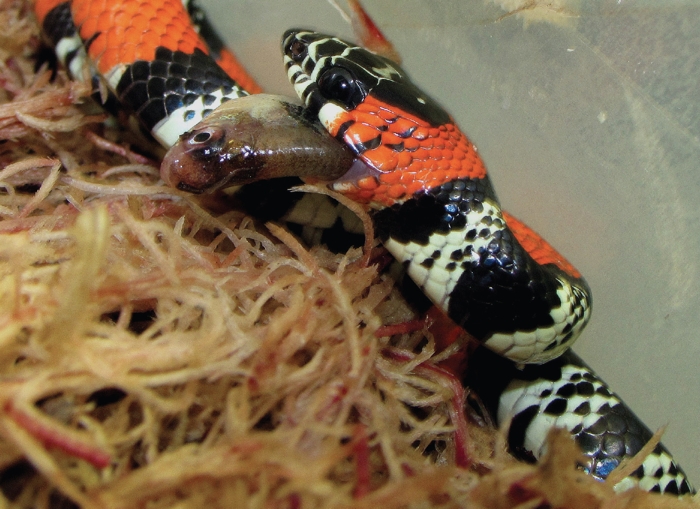The colubrid snake Simophis rhinostoma (Schlegel, 1837) is distributed in eastern Paraguay, and in Brazil it occurs in the western, southeastern and central regions (Peters & Orejas-Miranda 1970, Cacciali et al. 2009), with its distribution range extended into the northeastern region (Argôlo 1998). This species is found in Atlantic Forest and Cerrado areas (Colli et al. 2002, Costa et al. 2007, Sawaya et al. 2008).
The biology of Simophis rhinostoma is poorly known. Published data suggest it is a diurnal and terrestrial species, and there is no substantial information on diet (Sazima & Abe 1991, Sawaya et al. 2008). Some authors have previously mentioned that lizards and small rodents might be its prey items (Amaral 1976, Freitas 1999), however there are only records of ingestion of anurans in nature (Bizerra et al. 1994, França et al. 2008, Sawaya et al. 2008). In captive specimens, ingestion of small frogs and lizards was reported by Sazima & Abe (1991).
The species is uncommon, and in the lack of studies in the nature, observations of animals kept in captivity can add knowledge on the biology of the species (Souza 2004), providing information for conservation programs. We present a report of fish ingestion by Simophis rhinostoma, as an alternative way to feed the species in captivity, and some aspects of their feeding habits and defensive behavior.
In April 2015, a young female of Simophis rhinostoma (SVL = 250 mm; tail length = 56 mm; body mass = 9 g) from Araraquara, São Paulo state (21° 47′ S, 48° 10′ W), was collected and kept in captivity at Museu Biológico do Instituto Butantan for public exhibition.
Tadpoles of Lithobates catesbeianus (body mass ranging from 1-2 g; n = 4) were offered once a week, since newly metamorphosed frogs are too large for ingestion. However, only one tadpole was swallowed (25%) and regurgitated the following day.
Therefore, small fishes were tried as alternative food to Simophis rhinostoma, since we have observed its acceptance by non-piscivorous colubrid species kept in captivity. During 80 days, a total of 31 fishes (Hyphessobrycon eques; body mass ranging from 1-2 g) (Fig. 1) were offered twice a week. The mass of each prey ranged from 11-22% of the snake body mass.
When the first fish was ingested, the second was provided. The snake snapped the fishes mainly when they were offered in tweezers, but snapped too when they were left alive on the substrate (Sphagnum sp.). However, when the fishes were left on the water, the snake didn’t show interest. The time of ingestion ranged between 40 and 45 s, considered fast as observed in other colubrids eating small prey (Marques et al. 2014). We have succeeded in the feeding of Simophis rhinostoma with fishes in 64.5% of attempts (Table 1).
In the first attempts, the snake, right after seeing the fishes, showed some defensive displays before holding the prey, such as hiding and elevating its head, and locomotor escape. After few feeding attempts, the snake did not display the defensive behaviour and just approached and snapped the fishes, usually in the middle of the body, and manipulated their prey mainly to head first ingestion (80%).
This work presents the first report of fish ingestion by the snake Simophis rhinostoma. In captivity conditions, fishes could be an alternative prey to feeding this species. Our observations confirmed the similarity between the defensive behavior displayed by S. rhinostoma and coral snakes of the genus Micrurus, described by Sazima & Abe (1991), and Marques (2000).











 nueva página del texto (beta)
nueva página del texto (beta)




